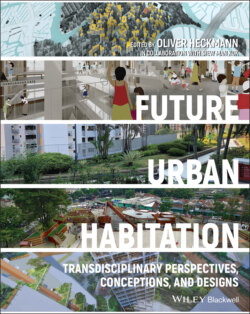Читать книгу Future Urban Habitation - Группа авторов - Страница 13
Adaptive and Responsive Habitation
ОглавлениеThe urban societies of the future will face pressing societal shifts, with dynamically diversifying forms of cohabitation with less consistent life cycles than before, shrinking ratios of nuclear families, increasing incidents of singlehood or childless couples and growing demands by senior populations ageing in place. In particular, the emerging care‐gaps are tendencies, to which urban habitats should be able to react with both their spatial configurations and their operations. Rising income inequalities and gentrification processes in urban neighbourhoods affect even middle‐class families, which necessitate new approaches for affordable housing. For particular generational groups like the millennials, the high housing costs can have grave implications for everything from social cohesion to family formation, forcing them to postpone ‘basic stages of adulthood’ (Barr and Malik 2016). Also changing work‐life balances are shifts that future habitats would have to accommodate, noting that these also coincide increasingly with significant increases of sometimes involuntary self‐employment connected often with low and unstable incomes (OECD 2019b), again necessitating affordable, flexible habitats.
These aspects challenge the adequacy of housing stocks, and the design of habitats will increasingly necessitate complementary strategies that reach beyond the pure facilitation of housing as shelter. The challenges are reflected in increasing debates about ‘Caring City’ and the ‘relational dimensions’ of habitats. They coincide – and correlate – with new attitudes and practices of sharing, regarding caregiving, working, serving and other practices. New cultures of living together in collaborative habitats have emerged that will as well affect urban habitation as such. In view of these tendencies adaptive and responsive habitats are considered necessary. Adaptability is seen as spatial capability to accommodate diverse forms of cohabitation and other appropriations, by spatial and programmatic diversity or flexibility. ‘Responsiveness’ – enabled by adaptability – empowers agencies and strategies for informal and formal practices within these habitats, to engender inclusive forms of coexistence and care.
As active contributors to these debates, two practising architects, two design researchers and experts on integrated health policies offer diverse perspectives how innovative concepts for built environments can with both their adaptability and their responsive operation cater to significant societal and demographic shifts and the diversifying needs and agencies of tenants during both the launch‐ and service lifetime of buildings.
Gérald Ledent, architecture professor at UC Louvain, questions how to design for a more diverse society with growing numbers of individuals being left behind and how to create new solidarities through housing. Several design strategies and respective cooperative projects are discussed, that question traditional dwelling paradigms and that – while being marginal today – could define new directions for housing.
The Viennese architect Bernd Vlay from StudioVlayStreeruwitz shares about the interdependencies between responsiveness and adaptation in housing typology. Discussing their recent social housing projects’ adaptability is not seen by him as the sole tool for resilient transformations. Its responsiveness rather emerges as curated co‐designs with multiple agencies and operations, significantly impacting also the role of architects.
Yee Wei Lim, a professor for medicine and a health policy researcher from National University of Singapore, and his team discuss how adaptable built environments and people‐responsive social innovations could contribute to the wellbeing particularly of senior citizens ageing in place. Integrative master plans, co‐location of care and health services, and various formal or informal models for intergenerational reciprocal support are presented.
Colin Neufeld from 5468796 architecture and Sharon Wohl from Iowa State University present flexible concepts to adapt to diverse needs during design processes, unprogrammed ‘white‐boxes’ providing residents with choice, and adaptable mini‐apartments as responses to dynamic needs. Open‐ended, collaborative urban designs offer antitheses to rigid master plans, engendering over time adaptability to multiple influences, agencies, and practices of co‐presence.
I myself discuss a design research on high‐rise types that are adaptable and responsive both at individual and communal domains. Societal shifts will necessitate a hybridization of what habitats entail, enabling user‐driven appropriations and relational practices beyond individual domains. Habitats are thus conceived as open‐ended, integrated physical and operational systems, with curated means and tools of sharing and decision‐making.
